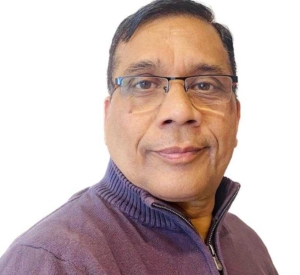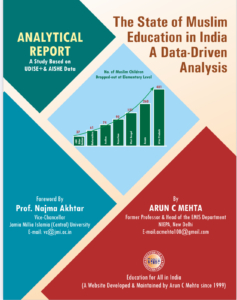Teacher Education in India: Professionalism through B.Ed, M.Ed, and Certification Courses?
Introduction
India’s commitment to universal school education, as a fundamental right under the Right to Education (RTE) Act, 2009, hinges on a robust cadre of professionally trained teachers. The National Education Policy (NEP) 2020 envisions a transformed education system where every teacher is equipped with contemporary skills to foster inclusive learning. However, recent UDISE+ 2024-25 data, as analysed on Education for All in India, paints a mixed picture: while total enrollment stands at 232.89 million across grades I-XII, challenges like declining GER at the elementary level (90.6%) and persistent gaps in teacher qualifications underscore the need for stronger professional pathways. With over 10 million teachers now serving in schools – a milestone crossed for the first time in 2024-25 – yet an estimated 10 to 12% lacking professional qualifications (roughly 1.2 million), programs like B.Ed, M.Ed, and certifications such as D.El.Ed and CTET are more crucial than ever.
This article provides an in-depth look at these programs, incorporating the latest insights from UDISE+ 2024-25. Aligned with the data-driven advocacy of Education for All in India, maintained by Prof. Arun C. Mehta, it also calls for a national common entrance test for teacher education – modelled after NEET for medicine, JEE for engineering, and CLAT for law—to ensure merit-based access, reduce regional disparities, and elevate the profession’s standards.
Historical Perspective
The foundations of teacher education in India were laid during the colonial period, with the establishment of the first Normal School in Madras in 1841 to train elementary educators. Post-independence, the sector gained momentum through landmark commissions. The University Education Commission (1948-49), led by Dr. S. Radhakrishnan, highlighted the need for professional training, leading to the structured B.Ed program in the 1950s. The Kothari Commission (1964-66) further emphasized advanced training, paving the way for M.Ed as a research-oriented postgraduate course.
The National Policy on Education (1986) institutionalized District Institutes of Education and Training (DIETs) for elementary levels, while the NCTE Act of 1995 created a regulatory body to standardize programs. The RTE Act, 2009, made qualifications mandatory, extending B.Ed to two years in 2015 for deeper pedagogical grounding. Certification courses like D.El.Ed evolved from the District Primary Education Programme (DPEP) in the 1990s. Today, these initiatives reflect India’s evolution toward competency-based education, though UDISE+ 2024-25 reveals ongoing hurdles, such as a 3.5% upper primary dropout rate, in achieving NEP’s 2030 goals.
The Role of NCTE in Teacher Education
The National Council for Teacher Education (NCTE), established as a statutory body under the NCTE Act, 1995, plays a pivotal role in regulating and promoting teacher education across India. Functioning under the Ministry of Education, NCTE sets norms and standards for programs like B.Ed, M.Ed, and diplomas, ensuring curriculum relevance, infrastructure quality, and faculty competence in over 15,000 approved institutions. It conducts inspections, grants recognition, and monitors compliance, preventing substandard training that could undermine RTE mandates.
NCTE also develops national curriculum frameworks, integrates NEP 2020 priorities like multidisciplinary learning and ICT, and addresses equity through reservations and scholarships. By maintaining a centralized database of institutions and programs, it facilitates transparency and accountability. However, critics, including analyses on Education for All in India, argue for NCTE to spearhead a unified entrance exam to streamline admissions, curb malpractices in state-level tests, and attract top talent – much like how NEET revolutionized medical admissions.
Current Review and Challenges
With more than 15,000 NCTE-approved institutions, teacher education enrols around 7 lakh students yearly. Samagra Shiksha’s 2024-25 allocation of over Rs. 38,000 crore supports training via platforms like NISHTHA, which has upskilled 60 lakh teachers since inception. Yet, UDISE+ 2024-25 highlights persistent issues: elementary GER dipped to 90.6% from 91.7% in 2023-24, signalling retention challenges amid a 2.08 million enrollment decline. Dropout rates improved marginally – 3.5% at upper primary (down from 5.2%) and 11.5% at secondary (from 14.1%) – but quality gaps remain, with single-teacher schools numbering 104,125 (a reduction but still significant) thanks to a 3.21% teacher increase, bringing the total to over 10 million and an average of 7 teachers per school.
An estimated 10 to 12% of the 10 million teachers – roughly 1.2 million – lack professional qualifications, concentrated in rural and elementary sectors, including 91.4% trained but only 87.7% professionally qualified at primary level. NEP 2020 aims for 100% trained teachers by 2030, but state variations (e.g., higher unqualified rates in Jammu & Kashmir and Meghalaya) and 10 lakh vacancies overall (7.5 lakh at elementary level) demand accelerated reforms. The absence of a common national entrance test exacerbates inequities, with fragmented state exams leading to uneven standards. Additionally, 7,993 zero-enrollment schools employ 20,817 teachers, pointing to deployment inefficiencies that need to be looked into without wasting any further time.
Detailed Overview of Key Programs
B.Ed (Bachelor of Education)
Who Requires It? Essential for secondary (classes 9-12) teachers in government and aided schools, per RTE norms.
Eligibility: Bachelor’s degree with 50% marks (45% for reserved categories); age 21-35 years. Entrance via state tests or CTET.
Duration: 2 years, blending theory, practice, and internships.
Number of Seats and Annual Intake: About 6-7 lakh seats nationwide, led by states like Uttar Pradesh (1+ lakh).
Who Conducts It? NCTE-affiliated universities (e.g., IGNOU for distance) and colleges.
Syllabus: Includes educational foundations, pedagogy, psychology, inclusive practices, and ICT, with NEP-aligned focus on holistic development.
Entrance Exams, Test Dates, and Pattern: State-specific (e.g., UP B.Ed JEE in May-June 2026; REET biannual). No single national test, though CTET qualifies. Format: 150 MCQs (2 hours) on aptitude, GK, and teaching skills.
Role of DIETs: DIETs support via practical training and workshops, though B.Ed is university-led.
M.Ed (Master of Education)
Who Requires It? For advanced teaching, administration, or research roles.
Eligibility: B.Ed with 50% marks.
Duration: 2 years, emphasizing research.
Number of Seats and Annual Intake: 1-1.5 lakh seats in 500+ programs.
Who Conducts It? Universities like Jamia Millia Islamia and IGNOU.
Syllabus: Research methods, policy analysis, evaluation, and dissertation, tied to Samagra Shiksha data use.
Entrance Exams, Test Dates, and Pattern: University-based (e.g., June-July); 100-150 MCQs on education theories.
Certification Courses (D.El.Ed, CTET, and Others)
Who Requires It? Elementary (1-8) educators.
Eligibility: 10+2 for D.El.Ed; graduation + qualification for CTET.
Duration: D.El.Ed: 2 years; CTET: Lifetime validity post-2019.
Number of Seats and Annual Intake: 5+ lakh for D.El.Ed; unlimited for CTET (biannual).
Who Conducts It? SCERTs for D.El.Ed; CBSE for CTET.
Syllabus: Child development, subject methods, EVS for elementary focus.
Test Dates and Pattern: CTET: July/December (e.g., July 2026); 150 MCQs (2.5 hours), 60% pass. State TETs similar, no pan-India beyond CTET.
Is B.Ed Essential for CTET/State TET? Required for upper levels; D.El.Ed for primary.
Role of DIETs: Core for D.El.Ed delivery and district training under Samagra Shiksha.
Opportunities and Job Security Post-Courses
These qualifications open doors to teaching in KVS/NVS (10,000+ vacancies yearly), private schools, edtech, and administration. With UDISE+ 2024-25 showing teacher numbers at over 10 million, demand remains strong amid 10 lakh vacancies. Government jobs offer security via TET panels; private roles provide flexibility. Professional courses are mandatory for RTE compliance, phasing out unqualified hires, with only 87.7-90.4% professionally qualified across levels.
Provisions in Samagra Shiksha for Teacher Training
Samagra Shiksha funds bridging courses, NISHTHA MOOCs, and DIET strengthening, targeting the unqualified gap. In 2024-25, it supports UDISE+ integration for qualification tracking, with scholarships for marginalized candidates. Despite progress – 91.4% trained at primary level – 12% unqualified persists due to access issues, contractual roles, and non-teaching duties.
Advocating for a Common National Entrance Test
Just as NEET unifies medical admissions and JEE streamlines engineering, India needs a National Teacher Eligibility Entrance Test (NTEET) for B.Ed/M.Ed. This would ensure fair selection, reduce disparities—evident in states like Kerala (97.5% qualified primary teachers) vs. Meghalaya (64.6%) – and align with NCTE’s regulatory mandate. As advocated on Education for All in India, such a system could attract diverse talent, curb coaching dependencies, and professionalize teaching – vital for NEP’s equity goals.
Concluding Observations
B.Ed, M.Ed, and certifications are indispensable for India’s teacher workforce, directly impacting UDISE+ metrics like the 11.5% secondary dropout and 104,125 single-teacher schools. With NCTE’s oversight and Samagra Shiksha’s support, scaling these programs – while implementing a common entrance – can bridge the 12% approx unqualified teacher divide and realize universal education.
Frequently Asked Questions (FAQs)
-
From a Student’s Perspective:
Q: What is NCTE’s role in B.Ed admissions?
A: NCTE regulates institutions and standards but doesn’t conduct entrances; it ensures program quality. For a unified process, push for NTEET. See NCTE Website.Q: How has UDISE+ 2024-25 affected B.Ed seat demands?
A: With 10 lakh vacancies and 12% unqualified teachers, demand rises; check state portals for 2025-26 seats. -
From a Teacher’s Perspective:
Q: Can unqualified teachers access Samagra Shiksha bridging in 2024-25?
A: Yes, via 6-month D.El.Ed equivalents; NISHTHA covers 60 lakh+. Details at Samagra Shiksha Portal.Q: Is CTET enough without B.Ed for secondary jobs?
A: No; B.Ed is required, but CTET qualifies. -
From an Administrator’s Perspective:
Q: How does NCTE help track unqualified teachers per UDISE+ 2024-25?
A: Through recognition norms and data alignment; integrate with UDISE+ for compliance, addressing 1.2 million unqualified. Visit Ministry of Education.Q: Why advocate for a common entrance like NEET?
A: To standardize merit, reduce disparities—echoing Education for All in India‘s call.
For deeper insights, download UDISE+ 2024-25 Analysis.





